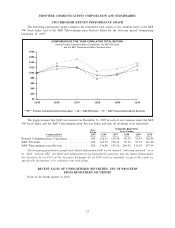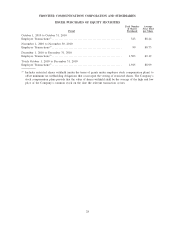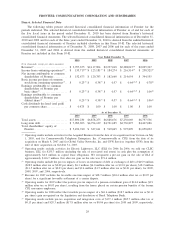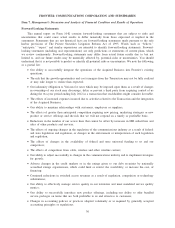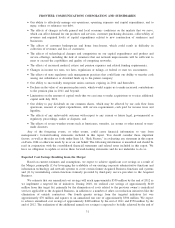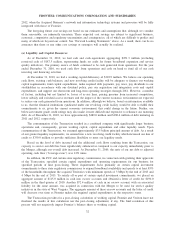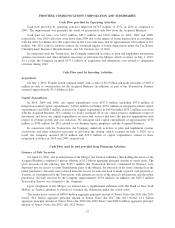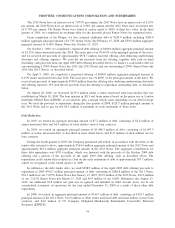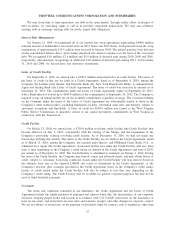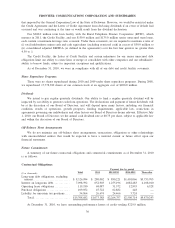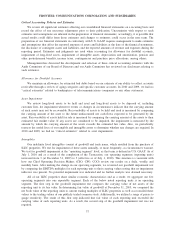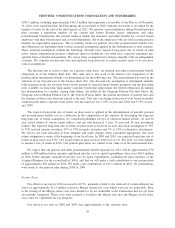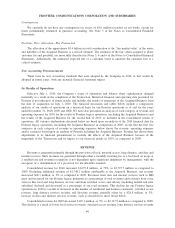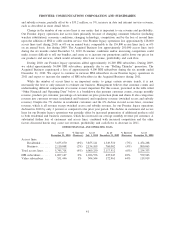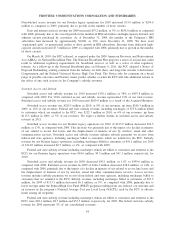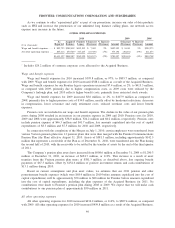Frontier Communications 2010 Annual Report Download - page 38
Download and view the complete annual report
Please find page 38 of the 2010 Frontier Communications annual report below. You can navigate through the pages in the report by either clicking on the pages listed below, or by using the keyword search tool below to find specific information within the annual report.Critical Accounting Policies and Estimates
We review all significant estimates affecting our consolidated financial statements on a recurring basis and
record the effect of any necessary adjustment prior to their publication. Uncertainties with respect to such
estimates and assumptions are inherent in the preparation of financial statements; accordingly, it is possible that
actual results could differ from those estimates and changes to estimates could occur in the near term. The
preparation of our financial statements in conformity with U.S. GAAP requires management to make estimates
and assumptions that affect the reported amounts of assets and liabilities at the date of the financial statements,
the disclosure of contingent assets and liabilities, and the reported amounts of revenue and expenses during the
reporting period. Estimates and judgments are used when accounting for allowance for doubtful accounts,
impairment of long-lived assets, impairment of intangible assets, depreciation and amortization, pension and
other postretirement benefits, income taxes, contingencies and purchase price allocations, among others.
Management has discussed the development and selection of these critical accounting estimates with the
Audit Committee of our Board of Directors and our Audit Committee has reviewed our disclosures relating to
such estimates.
Allowance for Doubtful Accounts
We maintain an allowance for estimated bad debts based on our estimate of our ability to collect accounts
receivable through a review of aging categories and specific customer accounts. In 2010 and 2009, we had no
“critical estimates” related to bankruptcies of telecommunications companies or any other customers.
Asset Impairment
We review long-lived assets to be held and used and long-lived assets to be disposed of, including
customer lists, for impairment whenever events or changes in circumstances indicate that the carrying amount
of such assets may not be recoverable. Recoverability of assets to be held and used is measured by comparing
the carrying amount of the asset to the future undiscounted net cash flows expected to be generated by the
asset. Recoverability of assets held for sale is measured by comparing the carrying amount of the assets to their
estimated fair market value. If any assets are considered to be impaired, the impairment is measured by the
amount by which the carrying amount of the assets exceeds the estimated fair value. Also, we periodically
reassess the useful lives of our tangible and intangible assets to determine whether any changes are required. In
2010 and 2009, we had no “critical estimates” related to asset impairments.
Intangibles
Our indefinite lived intangibles consist of goodwill and trade name, which resulted from the purchase of
ILEC properties. We test for impairment of these assets annually, or more frequently, as circumstances warrant.
We test for goodwill impairment at the “operating segment” level, as that term is defined in U.S. GAAP. As of
July 1, 2010 and as a result of the completion of the Transaction, our operating segments (reporting units)
increased from 3 (at December 31, 2009) to 5 (effective as of July 1, 2010). This structure is consistent with
how our Chief Operating Decision Makers (CEO, CFO, COO) review our results on a daily, weekly and
monthly basis. After making the change in our operating segments, we reviewed our goodwill impairment test
by comparing the EBITDA multiples for each reporting unit to their carrying values noting that no impairment
indicator was present. No potential impairment was indicated and no further analysis was deemed necessary.
All of our ILEC properties share similar economic characteristics and as a result, we aggregate our five
operating segments into one reportable segment. Each of the below noted reporting units is an operating
segment. The first step in the goodwill impairment test compares the carrying value of net assets of the
reporting unit to its fair value. In determining fair value of goodwill at December 31, 2010, we compared the
net book value of the reporting units to current trading multiples of ILEC properties as well as reconciled these
values to the trading values of our publicly traded common stock. Additionally, we utilized a range of prices to
gauge sensitivity. The result of this first step indicated that fair value of each reporting unit exceeded the
carrying value of such reporting units. As a result, the second step of the goodwill impairment test was not
required.
37
FRONTIER COMMUNICATIONS CORPORATION AND SUBSIDIARIES


